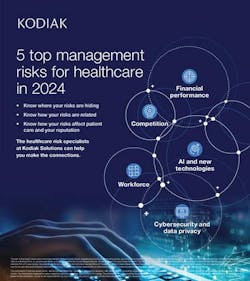INDIANAPOLIS -- Hospitals and medical practices face increasingly complex and interconnected risks that affect decision making in clinical, operational and financial matters, according to Kodiak Solutions’ annual report on the top management risks for healthcare.
Kodiak Solutions identified its top management risks through interviews with executive leaders and board members at many of the largest U.S. health systems, and risk assessments conducted at hundreds of hospitals, health systems, medical practices and other healthcare provider organizations.
Five top risks emerged consistently from those interviews and assessments:
- Artificial intelligence (AI) and new technologies
- Competition
- Cybersecurity and data privacy
- Financial performance
- Workforce
Kodiak Solutions defines a risk area as anything that could impede a healthcare organization’s ability to achieve its goals in critical areas like patient care, regulatory compliance, operations, strategic growth and financial performance.
“Each of these risk areas are causing significant disruption to many healthcare provider organizations’ core capabilities,” said Dan Yunker, Kodiak’s senior vice president, risk and compliance. “More importantly, each of these risk areas also carries the potential to ripple across the enterprise and amplify risks in other areas.”
AI’s spread requires a 360-degree risk assessment
AI tools, especially those based on generative AI models, are promising significant benefits for hospitals, health systems, medical practices and other provider organizations. These include:
- Efficiency through automating aspects of many processes,
- Faster, more accurate diagnoses and treatment decisions improving outcomes, and
- Enhancing the consumer experience for patients, e.g., appointment scheduling
To unlock these benefits, healthcare provider organizations need to mitigate a host of risks, such as:
- Storing and securing enormous amounts of data that is mostly protected health information (PHI),
- Protecting the training data for AI models from malicious actors seeking to introduce bad data, and
- Rooting out bias that can creep into in AI algorithms because of a lack of data for gender, sexual orientation, race and ethnicity.
Use of AI tools in healthcare also brings significant risks in other top risk areas.
- Cybersecurity and data privacy are ever-present challenges.
- The efficiencies that can be gained from AI tools must be weighed against the costs of implementing AI and training employees to use the tools properly to gauge the overall impact on financial performance.
- The benefits of AI tools can only be realized if the organization can solve the workforce challenges of recruiting employees with the right skills to manage these tools and their attendant risks, and training employees to use them.
- AI automation also could increase turnover as employees without the necessary skills to use these tools leave the organization, raising legal, reputational and cultural risks.
“The top risks we have identified affect each healthcare organization in its own way based on its current capabilities, the characteristics of its market and other factors,” Yunker said. “As a healthcare leader, you must evaluate how these risks impact your organization and then develop internal audit and compliance plans that allocate your limited resources to the most impactful risk areas for your organization.”
To view Kodiak Solutions’ full report on the five top management risks for healthcare in 2024, click here.




